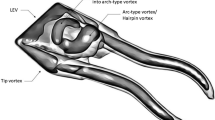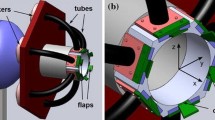Abstract
The present paper investigates drag reduction on a rectangular bluff body by employing base flaps and controlling flow separation with fluidic oscillators. Wind tunnel experiments are conducted to assess the influence of various parameters. The flap length has to be sufficiently long to shift the wake structures far enough downstream away from the base plate. Any additional increase in flap length does not yield any further benefits. The flap angle has to be large enough to provide a sufficient inward deflection of the outer flow. If the angle is too large, actuation becomes inefficient due to the pressure gradient imposed by the opposite side of the base perimeter. Furthermore, the flaps at high deflection angles provide additional area for low pressure to act in the streamwise direction and therefore negate the positive effects of actuation. The required actuation intensity is best governed by the ratio between jet and freestream velocity for varying oscillator spacing. For a flap angle of 20°, the smallest net drag is obtained at a velocity ratio of 4.5. Furthermore, the optimal velocity ratio for the most efficient drag reduction changes linearly with flap angle. Smaller flap deflections require a smaller velocity ratio for optimal control at different oscillator spacing. A net drag reduction of about 13 % is measured at a flap angle of 20° when the drag is corrected by the momentum input. Even if the measured drag is conservatively corrected by the energy coefficient, a net improvement of 7 % is achieved. For the current setup, the most efficient drag reduction is still obtained at smaller flap angles with a lower momentum input. However, the presented results support the general feasibility of this drag reduction approach with significant room left for optimization.





















Similar content being viewed by others
References
Ahmed S, Ramm G, Faltin G (1984) Some salient features of the time-averaged ground vehicle wake. SAE Technical Paper. doi:10.4271/840300
Barros D, Ruiz T, Borée J, Noack B (2014) Control of a three-dimensional blunt body wake using low and high frequency pulsed jets. Int. J. Flow Control 6(1):61–74. doi:10.1260/1756-8250.6.1.61
Browand F, Radovich C, Boivin M (2005) Fuel savings by means of flaps attached to the base of a trailer: field test results. SAE Technical Paper (2005-01-1016). doi:10.4271/2005-01-1016
Choi H, Lee J, Park H (2014) Aerodynamics of heavy vehicles. Annu Rev Fluid Mech 46:441–468. doi:10.1146/annurev-fluid-011212-140616
Cooper K (1985) The effect of front-edge rounding and rear-edge shaping on the aerodynamic drag of bluff vehicles in ground proximity. SAE Technical Paper (850288). doi:10.4271/850288
Duell E, George A (1999) Experimental study of a ground vehicle body unsteady near wake. SAE Technical Paper (1999-01-0812). doi:10.4271/1999-01-0812
Englar R (2001) Advanced aerodynamic devices to improve the performance, economics, handling and safety of heavy vehicles. Technical report, SAE Technical Paper. doi:10.4271/2001-01-2072
European Parliament (2014) Report on the proposal for a directive of the european parliament and of the council amending directive 96/53/ec of 25 july 1996 laying down for certain road vehicles circulating within the community the maximum authorised dimensions in national and international traffic and the maximum authorised weights in international traffic
Gaertlein S, Woszidlo R, Ostermann F, Nayeri C, Paschereit C (2014) The time-resolved internal and external flow field properties of a fluidic oscillator. In: AIAA 2014-1142, AIAA 52nd aerospace and science meeting. doi:10.2514/6.2014-1143
Hsu TY, Hammache M, Browand F (2004) Base flaps and oscillatory perturbations to decrease base drag. In: McCallen R, Browand F, Ross J (eds) The aerodynamics of heavy vehicles: trucks, buses, and trains, vol 19, Springer, Berlin, pp 303–316. doi:10.1007/978-3-540-44419-0_27
Hucho WH (2012) Aerodynamik der stumpfen Körper, 2nd edn. Vieweg+Teubner Verlag. doi:10.1007/978-3-8348-8243-1
Krajnović S, Davidson L (2003) Numerical study of the flow around a bus-shaped body. J Fluids Eng 125(3):500–509. doi:10.1115/1.1567305
Littlewood R, Passmore M (2012) Aerodynamic drag reduction of a simplified squareback vehicle using steady blowing. Exp Fluids 53(2):519–529. doi:10.1007/s00348-012-1306-4
Mason W, Beebe P (1978) The drag related flow field characteristics of trucks and buses. In: Sovran G, Moral T, Mason jr WT (eds) Aerodynamic drag mechanisms of bluff bodies and road vehicles, Springer, Berlin, pp 45–93. doi:10.1007/978-1-4684-8434-2_3
Nayeri C, Greenblatt D, Haff J, Paschereit C, Löfdahl L (2009) Drag reduction on a generic tractor -trailor using active flow control in combination with solid flaps. In: Browand F, McCallen R, Ross J (eds) Lecture Notes in Applied and Computational Mechanics 41. The aerodynamics of heavy vehicles II: trucks, buses and trains, pp 179–191
Ostermann F, Woszidlo R, Nayeri C, Paschereit C (2015a) Experimental comparison between the flow field of two common fluidic oscillator designs. In: AIAA 2015, AIAA 53rd AIAA aerospace sciences meeting. doi:10.2514/6.2015-0781
Ostermann F, Woszidlo R, Nayeri C, Paschereit CO (2015b) Phase-averaging methods for the natural flow field of a fluidic oscillator. AIAA J. doi:10.2514/1.J053717
Pastoor M, Henning L, Noack B, King R, Tadmor G (2008) Feedback shear layer control for bluff body drag reduction. J Fluid Mech 608:161–196. doi:10.1017/S0022112008002073
Roshko A (1993) Perspectives on bluff body aerodynamics. J Wind Eng Ind Aerodyn 49(1):79–100. doi:10.1016/0167-6105(93)90007-B
Schatzman D, Wilson J, Arad E, Seifert A, Shtendel T (2014) Drag-reduction mechanisms of suction-and-oscillatory-blowing flow control. AIAA J 52(11):2491–2505. doi:10.2514/1.J052903
Schmidt H, Woszidlo R, Nayeri C, Paschereit C (2015) Experimental investigation of the flow field behind a bluff body equipped with fluidic oscillators. In: AIAA 2015, AIAA 53rd AIAA aerospace sciences meeting. doi:10.2514/6.2015-0786
Seele R, Graff E, Lin J, Wygnanski I (2013) Performance enhancement of a vertical tail model with sweeping jet actuators. In: AIAA 2013, AIAA 51st AIAA aerospace sciences meeting, vol 411, p 2013. doi:10.2514/6.2013-411
Seifert A, Stalnov O, Sperber D, Arwatz G, Palei V, David S, Dayan I, Fono I (2009) Large trucks drag reduction using active flow control. In: The aerodynamics of heavy vehicles II: trucks, buses, and trains, Springer, pp 115–133. doi:10.1007/978-3-540-85070-0_10
Storms B, Ross J, Heineck J, Walker S, Driver D, Zilliac G, Bencze D (2001) An experimental study of the ground transportation system (gts) model in the nasa ames 7-by 10-ft wind tunnel. NASA/TM-2001-209621
Van Raemdonck G, Van Tooren M (2008) Time-averaged phenomenological investigation of a wake behind a bluff body. In: Proceedings of bluff bodies aerodynamics and applications VI International Colloquium, pp 20–24
Von Gosen F, Ostermann F, Woszidlo R, Nayeri C, Paschereit C (2015) Experimental investigation of compressibility effects in a fluidic oscillator. In: AIAA 2015, AIAA 53rd AIAA aerospace sciences meeting. doi:10.2514/6.2015-0782
Wood R (2004) Impact of advanced aerodynamic technology on transportation energy consumption. SAE Technical Paper, pp 01–1306. doi:10.4271/2004-01-1306
Woszidlo R, Wygnanski I (2011) Parameters governing separation control with sweeping jet actuators. In: AIAA 2011-3172, AIAA 29th applied aerodynamics conference. doi:10.2514/6.2011-3172
Woszidlo R, Nawroth H, Raghu S, Wygnanski I (2010) Parametric study of sweeping jet actuators for separation control. In: AIAA 2010-4247, AIAA 5th flow control conference. doi:10.2514/6.2010-4247
Woszidlo R, Stumper T, Nayeri C, Paschereit C (2014) Experimental study on bluff body drag reduction with fluidic oscillators. In: AIAA 2014-0403, AIAA 52nd aerospace and science meeting. doi:10.2514/6.2014-0403
Acknowledgments
This work is part of the research project “Investigation of the Unsteady Wake behind a Generic Tractor-Trailer with Different Boundary Conditions” (PA 920/26-1). The authors would like to thank the German Science Foundation (DFG) for the financial support.
Author information
Authors and Affiliations
Corresponding author
Rights and permissions
About this article
Cite this article
Schmidt, HJ., Woszidlo, R., Nayeri, C.N. et al. Drag reduction on a rectangular bluff body with base flaps and fluidic oscillators. Exp Fluids 56, 151 (2015). https://doi.org/10.1007/s00348-015-2018-3
Received:
Revised:
Accepted:
Published:
DOI: https://doi.org/10.1007/s00348-015-2018-3




